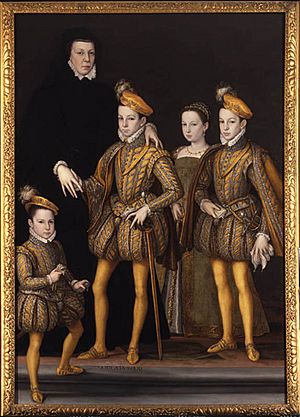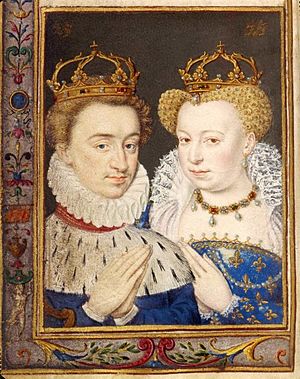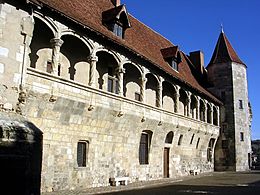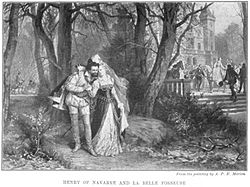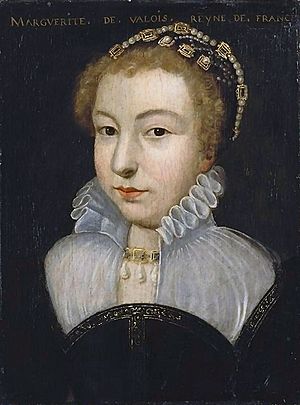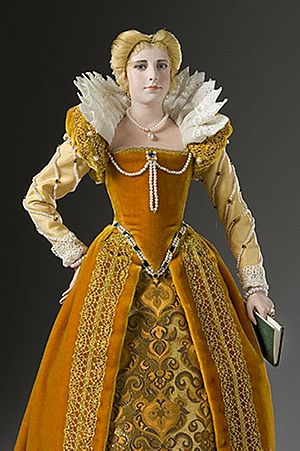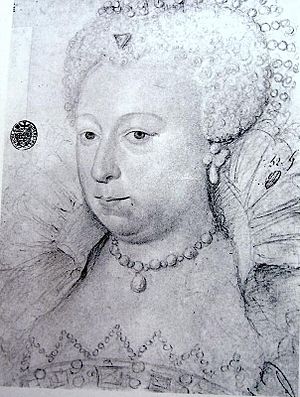Margaret of Valois facts for kids
Quick facts for kids Margaret of Valois |
|||||
|---|---|---|---|---|---|
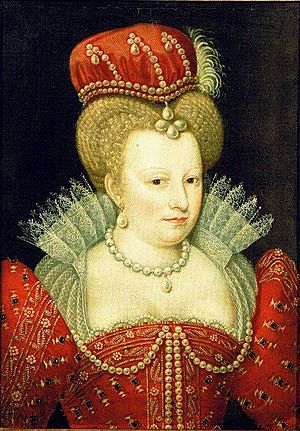 |
|||||
| Queen consort of France | |||||
| Tenure | 2 August 1589 – 17 December 1599 | ||||
| Queen consort of Navarre | |||||
| Tenure | 18 August 1572 – 17 December 1599 | ||||
| Born | 14 May 1553 Château de Saint-Germain-en-Laye, France |
||||
| Died | 27 March 1615 (aged 61) Hostel de la Reyne Margueritte, Paris, France |
||||
| Burial | Basilica of St Denis | ||||
| Spouse | |||||
|
|||||
| House | Valois | ||||
| Father | Henry II of France | ||||
| Mother | Catherine de' Medici | ||||
| Religion | Roman Catholicism | ||||
Margaret of Valois (French: Marguerite, born May 14, 1553 – died March 27, 1615), also known as La Reine Margot, was a French princess. She belonged to the Valois royal family. Margaret became the Queen of Navarre when she married Henry III of Navarre. Later, she also became Queen of France when her husband became King Henry IV in 1589.
Margaret was the daughter of King Henry II of France and Catherine de' Medici. Her brothers, Francis II, Charles IX, and Henry III, all became kings. Her marriage to the King of Navarre was meant to help bring peace between Catholics and Protestants in France. However, just six days after their wedding, the terrible St Bartholomew's Day massacre happened, and the French Wars of Religion started again.
As Queen of Navarre, Margaret tried to keep peace between her husband and the French royal family. She traveled between their courts, trying to make her marriage work. However, she could not have children, and the political problems of the time made her marriage difficult. In 1585, she chose to oppose her brother, King Henry III. She supported the Catholic League and was forced to live in Auvergne for 20 years. In 1599, she agreed to a "royal divorce," which meant her marriage was officially ended.
Margaret was a very smart and generous woman. She loved books and supported many artists and writers. She played a big part in the cultural life of the court, especially after she returned from exile in 1605. She was one of the first women to write her Memoirs (her life story) while she was held captive. Margaret was also a fashion icon of her time, influencing royal courts across Europe.
Contents
Life of Queen Margaret
Growing Up as a Princess
Margaret of Valois was born on May 14, 1553. She was born at the royal Château de Saint-Germain-en-Laye. She was the seventh child of Henry II and Catherine de' Medici. Three of her brothers would become kings of France: Francis II, Charles IX, and Henry III. Her sister, Elisabeth of Valois, married King Philip II of Spain.
Margaret spent her early years at the royal nursery. She was with her sisters Elisabeth and Claude. They were cared for by Charlotte de Vienne, a kind and religious lady. After her sisters married, Margaret lived at the Château d'Amboise with her brothers Henry and Francis. Her brother Charles IX gave her the nickname "Margot."
At the French court, Margaret studied many subjects. She learned grammar, classic literature, history, and the Bible. She could speak Italian, Spanish, Latin, and Greek, besides her native French. She was also good at writing, poetry, horse riding, and dancing. She traveled with her family and the court on a long tour of France from 1564 to 1566. During this time, she saw the difficult political situation in France. She learned about political talks from her mother.
In 1565, her mother, Catherine, met with the Duke of Alba. He was a main minister for King Philip II of Spain. Catherine hoped to arrange a marriage between Margaret and Carlos, Prince of Asturias. But the Duke of Alba did not agree to this marriage. Other marriage plans with Sebastian of Portugal and Archduke Rudolf also did not work out.
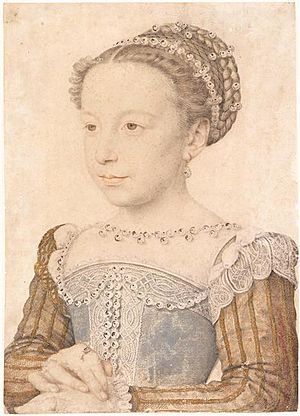
Margaret and her brother Henry were very close when she was a teenager. In 1568, Henry left court to lead the royal armies. He asked his 15-year-old sister to look after his interests with their mother. Margaret did this job well. But Henry did not show thanks when he returned. This caused problems between them.
The Vermillion Wedding
By 1570, Catherine de' Medici wanted Margaret to marry Henry de Bourbon of Navarre. He was the main leader of the Huguenots (French Protestants). Everyone hoped this marriage would make family ties stronger. The Bourbons were related to the French royal family. It was also hoped this marriage would end the French Wars of Religion between Catholics and Huguenots.
Margaret became engaged to Henry on April 11, 1572. Henry was a few months younger than Margaret. They liked each other at first. Henry's mother, Jeanne d'Albret, the Queen of Navarre, wrote about Margaret. She said Margaret was beautiful and smart. She also said Margaret had a lot of influence over the Queen-Mother and the King. Jeanne d'Albret died in June 1572. Henry became king, so Margaret became Queen of Navarre on her wedding day.
Margaret and Henry, both 19, married on August 18, 1572. The wedding took place at Notre Dame cathedral in Paris. A marriage between a Catholic and a Huguenot was unusual. Pope Gregory XIII did not approve the wedding. The different religions of the couple made for a unique wedding service. The King of Navarre had to stay outside the cathedral during the mass. Margaret's brother, the Duke of Anjou, stood in for him.
A historian from the 1600s, François Eudes de Mézeray, made up a story. He said Margaret was forced to marry Henry. He claimed her brother Charles IX pushed her head down to make it look like she agreed. This story was used later to justify ending the marriage. Margaret did not mention this in her Memoirs. No one else from her time did either.
Just six days after the wedding, many Protestants gathered in Paris for the wedding were killed. This event is known as the St. Bartholomew's Day Massacre.
In her Memoirs, Margaret wrote that she saved the lives of several important Protestants. She kept them in her rooms and refused to let assassins in. Her account of the massacre is the only one from the royal family. These events inspired Alexandre Dumas's famous novel La Reine Margot (1845). After the massacre, Catherine de' Medici suggested ending Margaret's marriage. But Margaret said it was not possible.
Political Challenges and Family Divisions
In 1573, King Charles IX became sicker. His brother Henry, who was next in line for the throne, was elected king of Poland. Henry supported stopping Protestant worship. So, some moderate Catholic lords, called Malcontents, planned to put Charles' youngest brother, Francis of Alençon, on the French throne instead. They joined with the Protestants and tried several times to take power.
Margaret first spoke out against this plot, even though her husband was involved. But later, she changed her mind. She hoped to become a key link between the moderate Catholics and her husband's Protestant supporters. She actively helped plan the coup d'état with her powerful friends.
In April 1574, the plot was discovered. The leaders were arrested and executed. After the plot failed, Francis and Henry were held as prisoners. Margaret wrote a letter asking for her husband's freedom. After Charles IX died, Henry III of France became king. Francis and Henry were set free, but they were watched. The new king did not forget Margaret's actions.
Relations between Henry and Margaret became difficult. Margaret did not have children. Henry had other relationships. However, their marriage was still a strong political alliance.
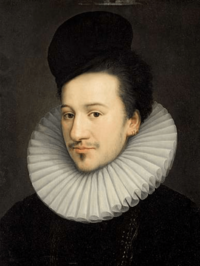
Alençon and Navarre eventually escaped. Henry did not even tell his wife he was leaving. Margaret was confined to her rooms in the Louvre palace. She was suspected of helping her husband.
Alençon joined the Protestants and started fighting. He refused to talk about peace until his sister was freed. So, Margaret was released. She helped her mother in peace talks. These talks led to the Edict of Beaulieu, which was very good for the Protestants and Alençon.
Henry of Navarre had become Protestant again. He wanted Margaret to join him in his kingdom of Navarre. During this time, they became closer. Margaret sent him important information from the court. But Catherine de' Medici and Henry III did not want her to go. They feared she would become a hostage or strengthen the alliance between Navarre and Alençon. However, Catherine believed Henry of Navarre might change his religion again. She used her daughter to try to bring him to Paris.
Diplomatic Mission and Exile
In 1577, Margaret asked to go on a mission to the southern Netherlands. This was for her younger brother Francis d'Alençon. The people of Flanders had rebelled against Spanish rule. They seemed willing to offer their throne to a foreign prince who was tolerant. This prince would also need to provide military help to protect their independence. Henry III agreed to his sister's plan. This would help him get rid of the troublesome Duke of Alençon.
Margaret left Paris, pretending to go for a bath in Spa thermal waters. She spent two months on her mission. At each stop, she met with gentlemen who were against Spain. She praised her brother and tried to convince them to join him. She also met Don Juan of Austria, the governor of the Netherlands. They had a friendly meeting in Namur. Almost a quarter of her Memoirs are about this mission. Returning to France was risky for Margaret, as the Spanish might capture her.
In the end, despite Margaret's efforts, Duke d'Alençon could not defeat the Spanish army. After reporting her mission to her brother, Margaret returned to court. Fighting increased between Henry III's friends and Alençon's supporters. In 1578, Alençon asked to leave. But Henry III thought this was proof of a plot. He had Alençon arrested in the middle of the night. Margaret joined him in his room. A few days later, Francis escaped again, with help from his sister's window.
Life at the Court of Nérac
Soon after, Margaret was finally allowed to join her husband. She denied helping her brother escape. Catherine also saw that years were passing and she still had no heir. She hoped for a new marriage for her son-in-law. Perhaps Henry III and the Queen-Mother also hoped Margaret could help bring peace to the troubled southwest provinces.
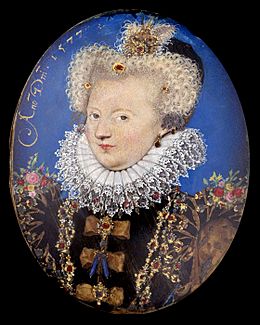
Margaret was joined by her mother and her chancellor, a famous humanist, when she returned with her husband. This journey was a chance to connect with the royal family. At the end of their trip, they met the King of Navarre. Catherine and her son-in-law agreed on how to carry out the latest peace agreement. This was the goal of the Nérac conference in 1579. Then, the Queen-Mother went back to Paris.
After her mother left, Margaret and Henry stayed briefly in Pau. Margaret found it difficult there because Catholic worship was forbidden.
Queen Margaret worked to create a refined court. She formed a true literary academy. Besides Agrippa d'Aubigné, Navarre's companion, and Pibrac, the poet Saluste du Bartas and Montaigne visited the court. Margaret had many discussions with Montaigne, who wrote the Essays.
A conflict started because the last peace agreement was not followed. There was also a disagreement between Navarre and the king's lieutenant-general in Guyenne. During this conflict, Margaret supported her husband. The conflict was short (1579–1580). This was partly thanks to Queen Margaret, who suggested asking her brother Alençon to lead the talks. The talks were quick and led to the peace of Fleix.
After Alençon left, Margaret's situation worsened. One of her ladies-in-waiting, Françoise de Montmorency-Fosseux, known as La Belle Fosseuse, was very close to the King of Navarre. She became pregnant. Margaret wanted to send her away from court. But La Belle Fosseuse refused to leave. She constantly turned Henry against his wife, hoping to marry him. Margaret remembered, "From that moment until the hour of [his mistress's] delivery, which was a few months after, [my husband] never spoke to me. [...] We slept in separate beds in the same chamber, and had done so for some time."
Françoise eventually gave birth to a daughter, but the child was stillborn. "It pleased God that she should bring forth a daughter since dead," wrote the queen in her Memoirs.
Rebellion and Long Exile
In 1585, Margaret did something very unusual for a queen of her time: she left her husband. She joined the Catholic League. This group brought together strict Catholics and people who did not like her family's policies. Margaret decided to take control of Agen, one of her own territories. The Queen of Navarre spent several months making the city stronger. She hired soldiers and sent them to attack nearby cities.
However, the people of Agen grew tired of the Queen's demands. They rebelled and sided with Henry III's lieutenant. When royal troops arrived, Margaret had to flee quickly. Her mother asked her to move to a royal estate, but Margaret refused. She went to her strong fortress of Carlat. She was with Jean de Lard de Galard, whom she made captain of her guards.
After a year, Margaret moved to the castle of Ibois, in Auvergne. This was probably because royal troops were getting close. Her mother had suggested this place. But she found herself surrounded by royal troops who took the fortress. She waited for almost a month to find out what would happen to her.
On October 13, 1586, Margaret was imprisoned by her brother Henry III. She was held in the castle of Usson, in Auvergne. Her captain, d'Aubiac, was executed in front of Margaret, even though Catherine de' Medici did not want this. Margaret thought she was going to die. She wrote a "farewell" letter to the Queen-Mother. She asked that after her execution, doctors check her body to prove she was not pregnant.
But then, her jailer, the Marquis de Canillac, changed sides in the civil war. He joined the Catholic League and released her in early 1587. Her freedom was good for the League. It meant Henry of Navarre would remain without a son to inherit his throne.
Even though she was free, Margaret decided to stay at Usson castle. She spent eighteen years there. Not much reliable information exists about her life in Usson, so many stories have grown around it. While there, she learned of her mother's death. She also learned of her brother Henry III's assassination in 1589. Her husband, Henry of Navarre, became King of France as Henri IV. However, most Catholics did not accept him until he converted to Catholicism four years later.
During this time, Margaret created a new court of smart people. She had musicians and writers, just like she did at Nérac. She fixed up the castle. She spent her time reading many books, especially religious ones. Her financial situation also got better. Her sister-in-law, Elisabeth of Austria, who she always got along with, started sending her half of her income.
In 1594, Margaret received a letter from her friend Pierre de Bourdeille, known as Brantôme. It was a praiseful text about her, but it had some mistakes and false rumors. In response, she wrote her Memoirs. She was the first woman to write her own life story.
Her book was dedicated to Brantôme. It was her autobiography from childhood until 1582. The Memoirs were published after her death in 1628. Queen Margaret was also visited by writers. These included the loyal Brantôme, but also Honoré d'Urfé and Joseph Scaliger. Honoré d'Urfé was likely inspired by Margaret to create a character in his novel L'Astrée.
Reconciliation and Marriage Annulment
By 1593, Henry IV first suggested ending his marriage to Margaret. Margaret started talking to him again to improve her financial situation. It was clear she could not have children. But she knew the new King needed a legitimate son to make his power strong. For this, he needed his wife's support because he wanted to marry again.
Talks began after peace returned and Henry IV became Catholic again. To show the marriage was not valid to the pope, the King and Margaret said they could not have children. They also said they were too closely related. And they pointed out problems with the wedding ceremony itself. During these talks, Margaret's financial situation improved. But she did not like the idea of Henry marrying his mistress, Gabrielle d'Estrées. Gabrielle was the mother of his son, César, who was made legitimate in 1595. Margaret refused to support what she saw as a shameful remarriage. She said, "It is wrong for me to put in my place a woman of such low birth and bad life as the one people are talking about."
She stopped the talks. But after Gabrielle died, Margaret agreed to the annulment. She asked for a large amount of money and the right to keep her royal title. During the trial, many witnesses repeated the false story that Margaret had been forced to marry Henry by her mother and brother Charles IX. Pope Clement VIII officially canceled the marriage on October 24, 1599. Later, on December 17, 1599, the Archbishop of Arles also announced the annulment of Henry's marriage to Margaret of Valois. A year later, Henry IV married Marie de' Medici. Nine months later, she gave him a son, Louis.
After their marriage was annulled, Margaret and Henry remained on good terms. After twenty years of exile, Margaret was back in the good graces of the King of France. Her situation was unusual, but her new position allowed her to receive visitors at Usson. They were charmed by the cultural life of this "new Parnassus" and her generosity.
Margaret was well-informed in Auvergne. She noticed the plans of the Count of Auvergne. He was the illegitimate son of King Charles IX of France. He was also the half-brother of Henriette d'Entragues, a former partner of King Henry IV. In 1604, the King was informed and ordered the capture of the Count and the seizure of all his property. Queen Margaret was supposed to inherit property from her mother, Catherine de' Medici, but her brother Henry III had given it to this ally instead. Margaret started a long legal case. The King allowed her to return to Paris to handle her case.
Final Years in Paris
In 1605, after nineteen years in Usson, Margaret returned to Paris. She surprised Parisians with her appearance. Her skin was red, and she wore a very fancy blonde wig. Her clothes were twenty years out of style. But despite this, she won the affection of the people. She had changed little in her tastes, but she had become "horribly stout," according to Tallemant des Réaux.
In Paris, Queen Margaret became a supporter of the arts and a helper of the poor. She was also very religious. Vincent de Paul was her chaplain.
In 1606, she won her lawsuit against her nephew. She gained her entire inheritance from her mother. After this, Margaret named the Dauphin Louis as her heir. This was a very important political move for the Bourbon family. It officially passed the royal line from the Valois family, of which Queen Margaret was the last legitimate member, to the Bourbon dynasty, which was now on the French throne.
This also strengthened her friendship with Queen Marie de' Medici. It helped to show that the claims of Henriette d'Entragues were not valid. Henriette was the sister of Charles of Valois and a partner of Henry IV. She claimed her son was the rightful heir because the King had promised to marry her. Margaret often helped plan court events and cared for the children of Henry IV and Marie. In 1608, when Prince Gaston of France was born, Queen Margaret was chosen by the King to be his godmother.
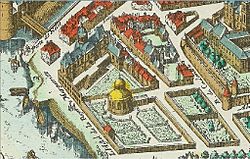
She set up her home on the Left Bank of the Seine river. This was called the Hostel de la Reyne Margueritte. It was built for her by Jean Bullant in 1609. This palace became a center for politics and ideas in Paris. Queen Margaret hosted grand parties with plays and ballets that lasted all night. She also opened a literary salon. Here, she gathered philosophers, poets, and scholars.
On May 13, 1610, Queen Margaret attended Marie's coronation at Saint Denis. The next day, Henri IV was killed by a monk. Marie de' Medici became the regent for their young child. Margaret was given various diplomatic roles. She received foreign ambassadors at court. She helped with celebrations for Louis XIII's future marriage. In 1614, she was asked to negotiate with clergy representatives at the Estates General. This was her last public duty.
Also in 1614, she joined a debate about women's roles. She responded to a text she thought was against women. She wrote The Learned and Subtle Discourse. In it, she said women were superior to men. She argued that God created the world from lower to higher creatures. Woman was the last creature made, not even from mud like Adam, but from a rib. She also said that women's delicate beauty showed their perfection. For Queen Margaret, the world was not "made for man and man for God, but rather the world is made for man, man made for woman, and woman made for God."
In early March 1615, Margaret became very ill. She died in her Hostel de la Reyne Marguerite on March 27, 1615. Paul Phélypeaux de Pontchartrain wrote, "On March 27 – there died in Paris, Queen Margaret, the sole survivor of the Valois family; a princess full of kindness and good intentions for the welfare and peace of the State, and who was her only enemy. She was deeply regretted."
Queen Margaret was buried in the Valois family chapel. This was at the Basilica of St. Denis. Her coffin has disappeared. No one knows if it was moved or destroyed during the French Revolution.
In Books and Movies
The 1845 novel by Alexandre Dumas, père, La Reine Margot, tells a fictional story. It is about the events around Margaret's marriage to Henry of Navarre. This novel was made into a film three times. The 1994 version was nominated for an Academy Award for Costume Design. Margaret was played by Isabelle Adjani.
The play Love's Labour's Lost (1594–1595) by William Shakespeare might be based on an attempt to make peace between Margaret and Henry in 1578.
Margaret appears in Jean Plaidy's novel, Myself, My Enemy. This is a fictional memoir of Queen Henrietta Maria. She also appears in Plaidy's Catherine de Medici series. This series focuses on her mother, Catherine de' Medici. Margaret is mostly in the second book, The Italian Woman, and also in the third book, Queen Jezebel. Sophie Perinot's 2015 novel Médicis Daughter covers Margaret's teenage years and the early days of her marriage.
Margaret of Valois also has a big role in the Meyerbeer opera Les Huguenots. This was one of the most famous roles for the Australian singer Joan Sutherland. She performed it for her farewell show for the Australian Opera in 1990. She also appears in the comic opera Le pré aux clercs, by Ferdinand Herold.
Margot was played by Rebecca Liddiard in the final episode of the TV series Reign.
Images for kids
-
Princess Margaret of Valois. Portrait by François Clouet, 16th century.
-
Francis, Duke of Alençon. Portrait by Jean Decourt (1576).
-
Queen Margaret of Navarre, by Nicholas Hilliard (1577)
-
L'Hostel de la Reine Marguerite built by Jean Bullant in 1609, and its gardens, as shown in Matthäus Merian 1615 plan of Paris.
-
Queen Margaret in 1610. Coronation of Marie de' Medici in St. Denis (detail), by Peter Paul Rubens, 1622–1625.
See also
 In Spanish: Margarita de Valois para niños
In Spanish: Margarita de Valois para niños


